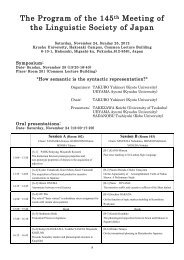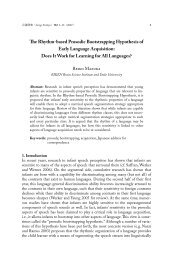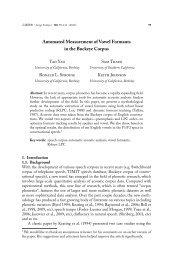第117åæ¥æ¬è§£åå¦ä¼ç·ä¼ã»å ¨å½å¦è¡éä¼ è¬æ¼ããã°ã©ã ã»æé²é PDF ...
第117åæ¥æ¬è§£åå¦ä¼ç·ä¼ã»å ¨å½å¦è¡éä¼ è¬æ¼ããã°ã©ã ã»æé²é PDF ...
第117åæ¥æ¬è§£åå¦ä¼ç·ä¼ã»å ¨å½å¦è¡éä¼ è¬æ¼ããã°ã©ã ã»æé²é PDF ...
Create successful ePaper yourself
Turn your PDF publications into a flip-book with our unique Google optimized e-Paper software.
148<br />
117 <br />
P<br />
Conserved properties of dendritic trees in four cortical interneuron<br />
subtypes<br />
1,2 1,2 2,3 1,2<br />
1<br />
2 CREST 3 <br />
<br />
Dendritic trees influence synaptic integration and neuronal excitability, yet<br />
appear to develop in rather arbitrary patterns. Using electron microscopy and<br />
serial reconstructions, we analyzed the dendritic trees of four morphologically<br />
distinct neocortical interneuron subtypes to reveal two underlying organizational<br />
principles common to all. First, crosssectional areas at any given point within<br />
a dendrite were proportional to the summed length of all dendritic segments<br />
distal to that point. Consistent with this observation, total crosssectional area<br />
was almost perfectly conserved at bifurcation points. Second, dendritic cross<br />
sections became progressively more elliptical atmore proximal, larger diameter,<br />
dendritic locations. Finally, computer simulations revealed that these conserved<br />
morphological features limit distance dependent filtering of somatic EPSPs and<br />
facilitate distribution of somatic depolarization into all dendritic compartments.<br />
Because these features were shared by all interneurons studied, they may represent<br />
common organizationalprinciples underlying the otherwise diverse morphology of<br />
dendritic trees.<br />
P<br />
FABP in astrocytes is involved in control of neuronal dendritic<br />
formation<br />
Majid Ebrahimi, Yshiteru Kagawa, Kazem Sharifi, Yasuhiro Adachi,<br />
Tomoo Sawada, Nobuko Tokuda, Yuji Owada<br />
Department of Organ Anatomy, Yamaguchi University Graduate School of<br />
Medicine<br />
Alteration of fatty acid homeostasis in brain is associated with human functional<br />
psychosis. We previously showed that FABP7 braintype fatty acid binding<br />
protein, a cellular fatty acid chaperon abundantly expressed in astrocytes, is<br />
involved in control of emotional behavior. However, mechanism by which FABP7<br />
in astrocytes modulates neuronal activity is still unknown.<br />
Mixed cortical culture and neuron/astrocyte coculture were established from<br />
wildtype WT and FABP7 KO KO mice, and morphology of pyramidal<br />
neurons was evaluated by NeuronMetrics. GolgiCox staining was performed to<br />
examine dendrite morphology of neurons in cerebral cortex of KO mice.<br />
In mixed cortical culture, pyramidal neurons of KO mice showed decrease in<br />
length and number of dendritic branches. In the WT neuron/KO astrocyte hybrid<br />
coculture WTn/KOa such changes in dendrite morphology were also detected<br />
compared to WTn/WTa coculture. Moreover, pyramidal neurons in prefrontal<br />
cortex of KO mice showed aberrant dendrite formation.<br />
FABP7 may regulate neuronal dendrite formation by modulation of lipid<br />
homeostasis metabolism/signal transduction in astrocytes.<br />
P<br />
FILIP <br />
1 1 1 1 1 1 <br />
1,2 1<br />
1<br />
<br />
2<br />
<br />
<br />
<br />
<br />
<br />
<br />
<br />
FILIP <br />
A <br />
<br />
FILIP <br />
FILIP <br />
<br />
<br />
P<br />
CA <br />
<br />
<br />
<br />
<br />
<br />
<br />
CA1 <br />
<br />
Thy1 GFP <br />
9 2 <br />
mushroom type stubby type thin type <br />
CA1 Western blot<br />
<br />
BDNF PSD95 <br />
BDNF PSD95<br />
<br />
<br />
<br />
BDNFPSD95 <br />
<br />
P<br />
In vivo analysis of postsynaptic molecular dynamics in the<br />
developing mouse cortex<br />
<br />
<br />
Dynamic behavior of postsynaptic molecules is thought to play important<br />
roles in synaptic transmission and plasticity. Postsynaptic densities PSDs and<br />
spines are key elements in the process of postsynaptic signal transduction. We<br />
previously reported differential dynamics of molecules present in PSDs and<br />
spines in cultured hippocampal neurons. Photobleaching of actin, the prominent<br />
cytoskeletal component in the spine cytoplasm, and PSD scaffolding proteins<br />
PSD95 and Homer1c showed distinct mobility in the postsynaptic cytoplasm,<br />
indicating independent regulation of molecular dynamics. To gain more insights in<br />
the protein mobility at the postsynaptic sites and its regulation, information from<br />
neurons in the native environment should be obtained. To monitor protein mobility<br />
in vivo, we applied twophoton photoactivation/bleaching to pyramidal neurons<br />
in the mouse cortex and monitored fluorescence decay/recovery in individual<br />
spines at different developmental stages. Lifetime of PSD/spine structure was<br />
much longer than resident times of individual protein molecules, indicating the<br />
importance of protein network in maintenance of the postsynaptic structural<br />
organization.<br />
P<br />
Direct monitoring of AMPA receptor recycling and trafficking<br />
Ayako Hayashi 1 , Daisuke Asanuma 2 , Mako Kamiya 3 , Yasuteru Urano 3 , Shigeo<br />
Okabe 1<br />
1<br />
Department of Cellular Neurobiology, Graduate School of Medicine, The<br />
university of Tokyo, 2 Department of Neurobiology, Graduate School of Medicine,<br />
The university of Tokyo, 3 Department of Chemical Biology and Molecular<br />
Imaging, Graduate School of Medicine, The university of Tokyo<br />
Longlasting change of synaptic efficacy, such as LTP, is known to be correlated<br />
with increase of postsynaptic response of AMPAtype glutamate receptors<br />
AMPARs. AMPAR targeting is regulated by surface mobility and exo/<br />
endocytosis. Although single particle tracking revealed contribution of AMPAR<br />
lateral mobility in their trapping at the synaptic sites, dynamic recycling of<br />
AMPARcontaining vesicles after plasticityinducing stimuli has not yet been<br />
clarified. We expressed AMPAR subunit GluR1 tagged with ZIPbinding cassette<br />
in primary hippocampal neurons and visualized cell surface AMPARs by labeling<br />
with ZIP peptides conjugated with pH sensitive dye RhPM. RhPMlabeled<br />
GluR1 increased its fluorescence after endocytosis, due to the acidification in<br />
the endosomal compartment. To visualize the intracellular transport of GluR1<br />
containing vesicles after endocytosis, we monitored both superecliptic pHluorin<br />
tagged GluR1 and RhPMlabeled GluR1 simultaneously. We identified that GluR1<br />
endocytosis occurred on dendritic shafts and also in larger spines. Reciprocal<br />
signal change of SEP/RhPMlabeled receptors facilitates the identification of exo/<br />
endocytotic events within dendritic spines.







